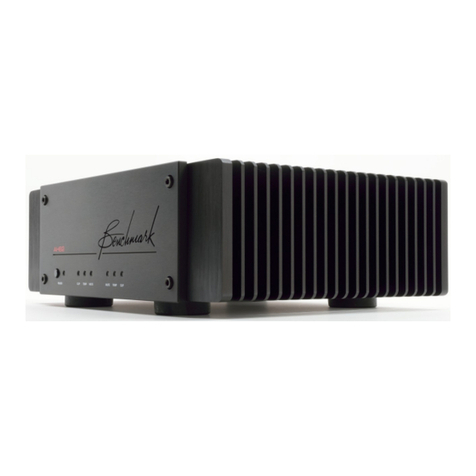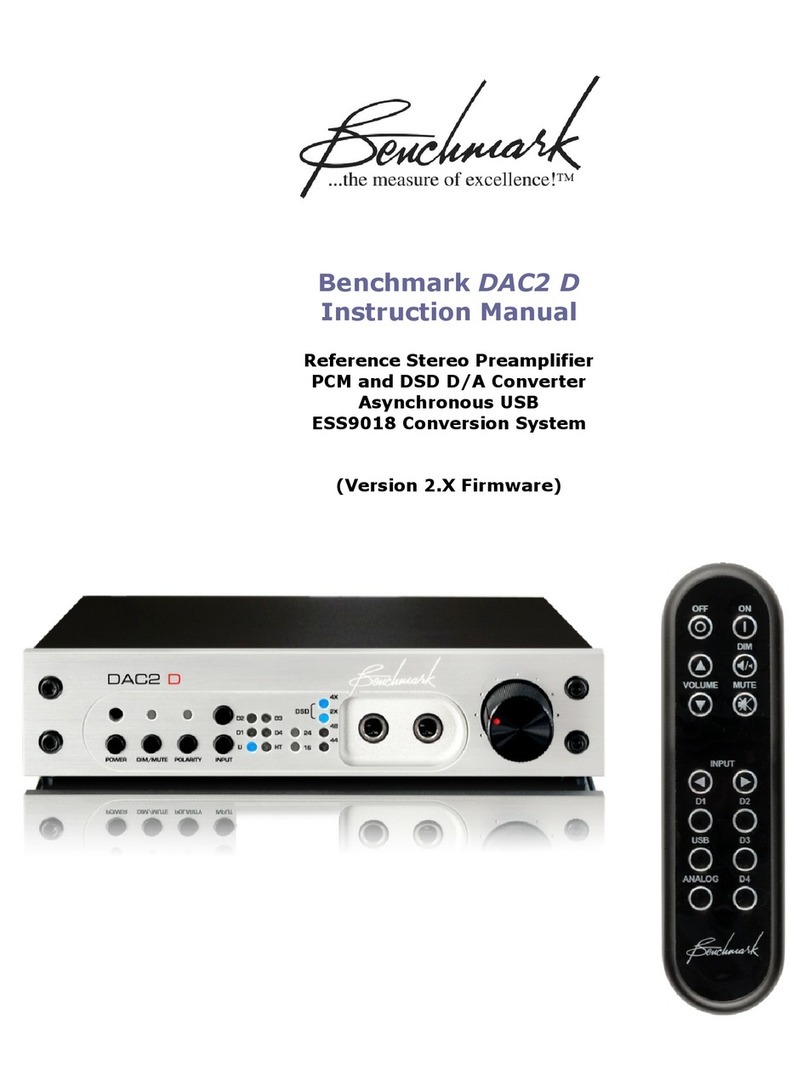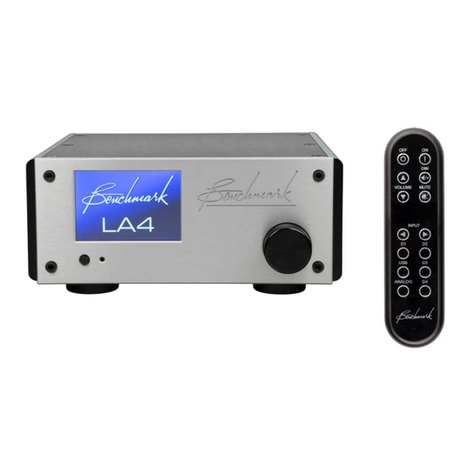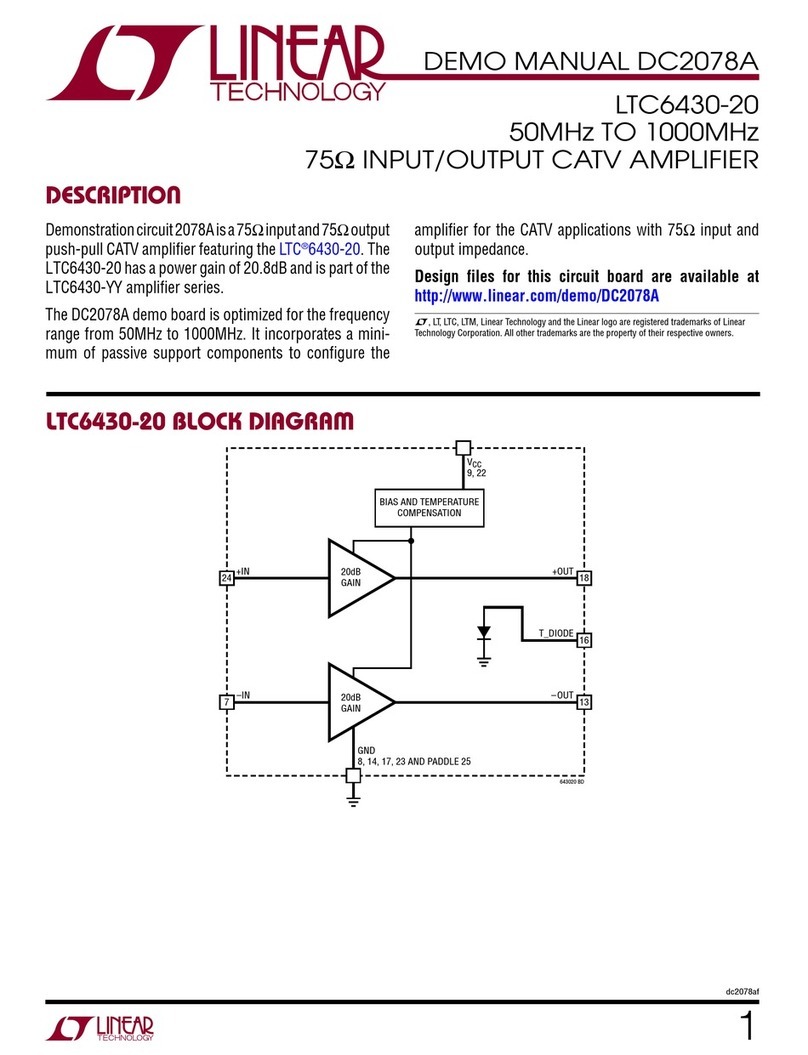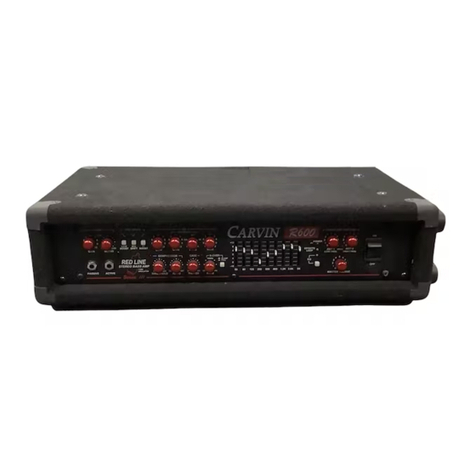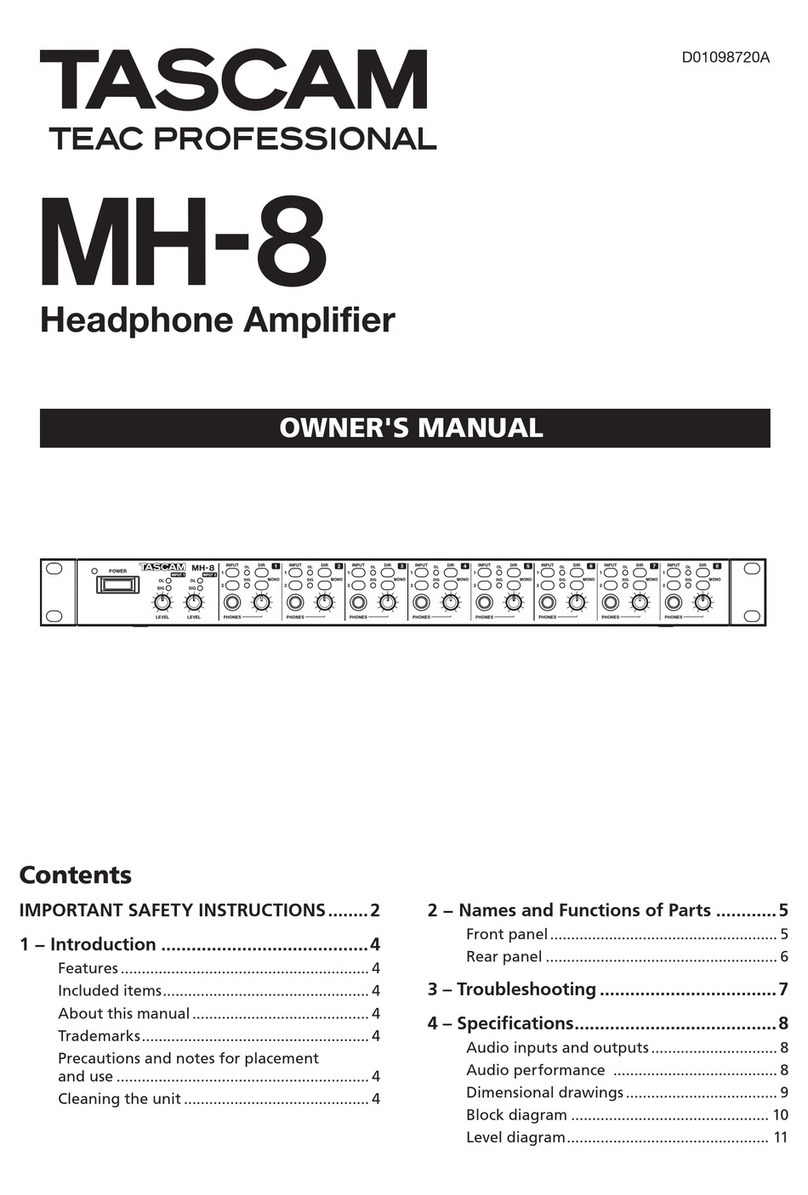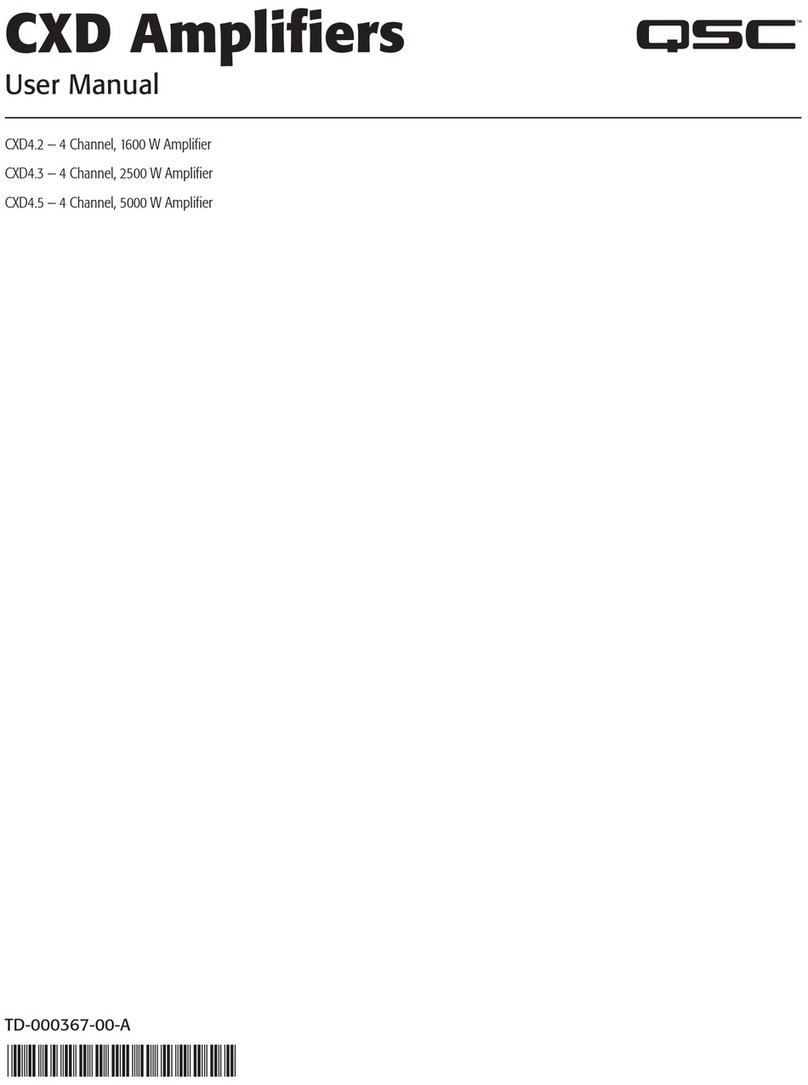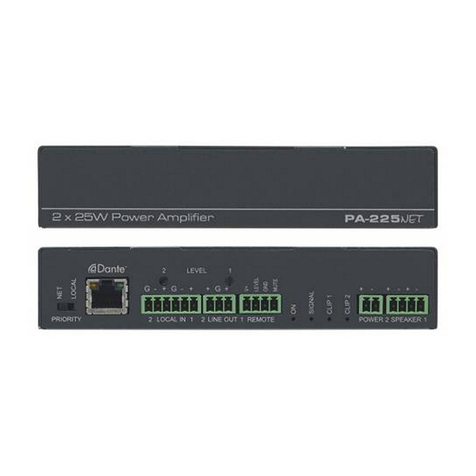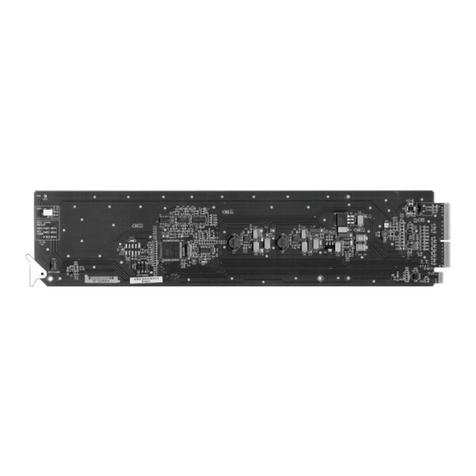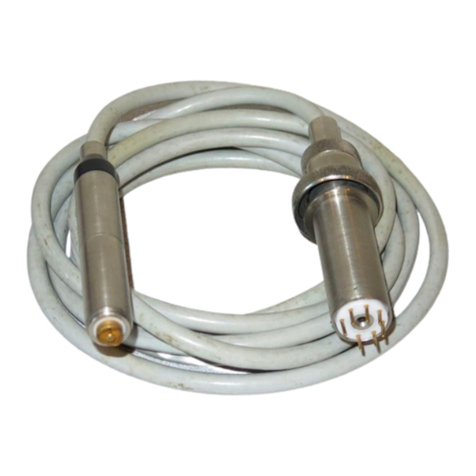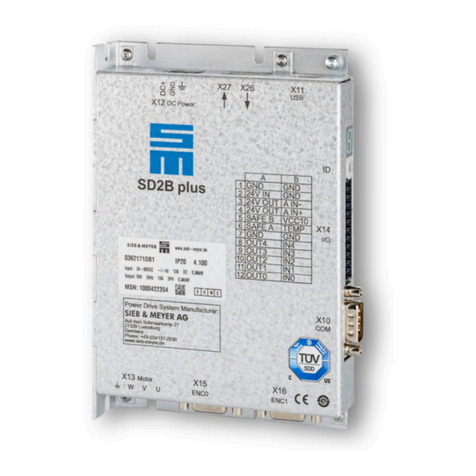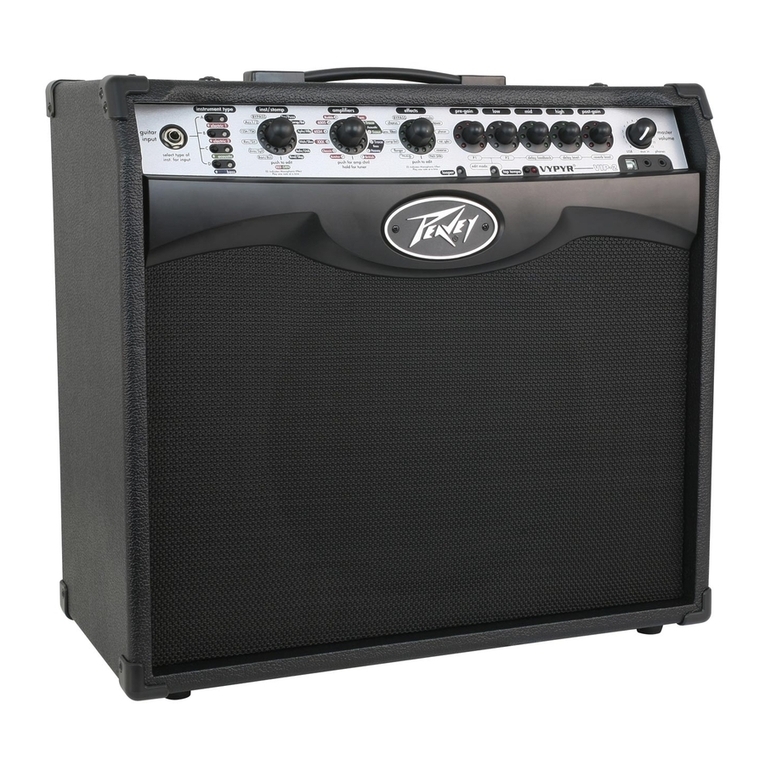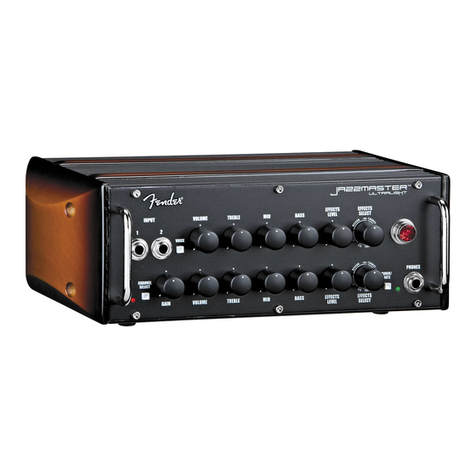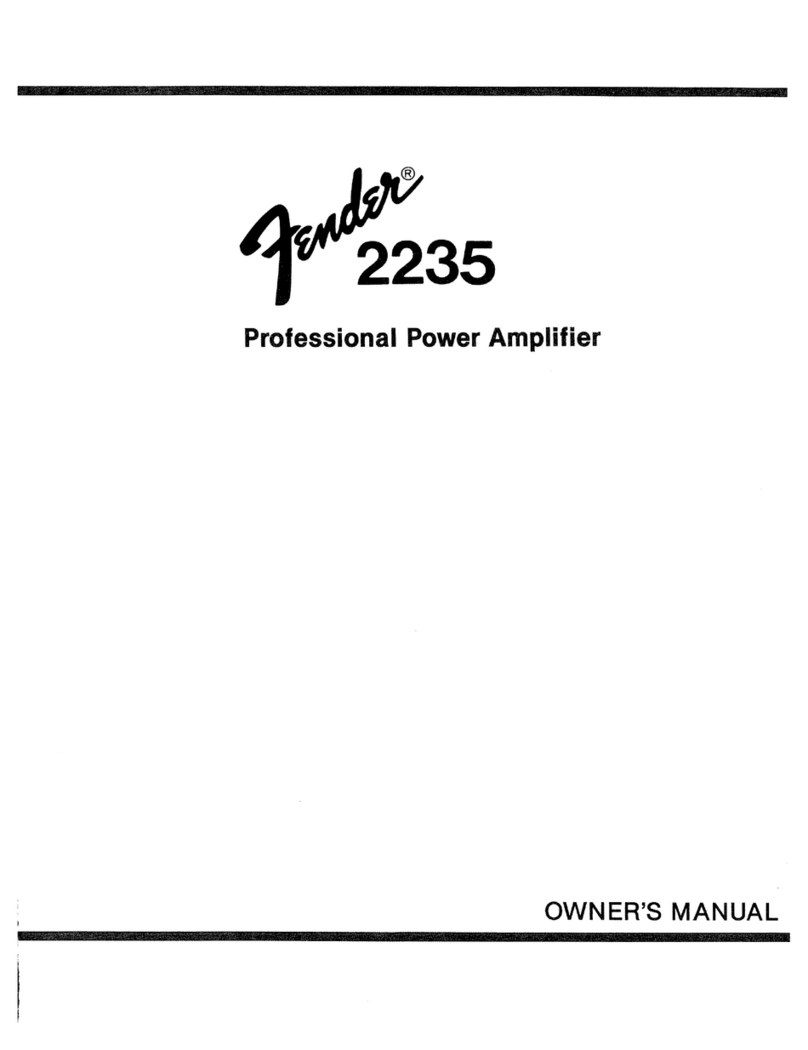Benchmark DAC1 HDR User manual

Benchmark
DAC1 HDR
Instruction Manual
Stereo Preamplifier
w/ Remote Control, Digital-to-Analog Converter,
Headphone Amplifier and Computer Audio Interface

DAC1 HDR
Instruction Manual Rev A Page 2
Safety Information
Voltage Selection
CAUTION: THE FUSE DRAWER INCLUDES
A VOLTAGE SELECTION SWITCH WITH
TWO SETTINGS: ‘110’ AND ‘220’. CHECK
TO SEE THAT IT IS PROPERLY
CONFIGURED FOR YOUR LOCATION
BEFORE CONNECTING AC POWER.
Incorrect configuration may blow fuses or
cause erratic operation.
Repair
CAUTION: DO NOT SERVICE OR REPAIR
THIS PRODUCT UNLESS PROPERLY
QUALIFIED. ONLY A QUALIFIED
TECHNICIAN SHOULD PERFORM
REPAIRS.
Fu e
CAUTION: FOR CONTINUED FIRE
HA ARD PROTECTION ALWAYS REPLACE
THE FUSES WITH THE CORRECT SI E
AND TYPE (0.5A 250 V SLO-BLO
®
5 X 20
MM – LITTELFUSE® HXP218.500 OR
EQUIVALENT).
Modification
CAUTION: DO NOT SUBSTITUTE PARTS
OR MAKE ANY MODIFICATIONS
WITHOUT THE WRITTEN APPROVAL OF
BENCHMARK MEDIA SYSTEMS, INC.
MODIFICATION MAY CREATE SAFETY
HA ARDS AND VOID THE WARRANTY.
NOTICE: CHANGES OR MODIFICATIONS
NOT EXPRESSLY APPROVED BY
BENCHMARK MEDIA SYSTEMS COULD
VOID THE USER'S AUTHORITY TO
OPERATE THE EQUIPMENT UNDER FCC
REGULATIONS.

DAC1 HDR
Instruction Manual Rev A Page 3
Contents
Safety Information 2
Voltage Selection 2
Repairs 2
Fuses 2
Modifications 2
Content 3
Feature 4
Overview 5
DAC1 Heritage 5
Applications 5
HDR-VC™ 5
AdvancedUSB Audio™
Jitter-Immune UltraLock™
HPA2™ Headphone Amplifier
High-Current Output Drivers
‘Audio-Always’ Design Philosophy
Low-Noise Internal Power Supply 7
Phase-Accurate Multi-Track and 5.1 7
Automatic Digital De-Emphasis 7
Quick Start Guide 8
Audio Inputs 8
Remote Control 8
Volume Control Modes 9
Direct Interfacing to Power Amplifiers 9
Source Selector and ON/OFF Switch 9
Input Status Display 9
Mute on Headphone Insertion 9
Front Panel 10
Input Status Display 10
Error Indication 10
Source Selector and ON/OFF Switch 11
HPA2
TM
Headphone Jacks 11
Volume Control 12
Rear Panel 13
Analog Input – RCA Unbalanced 13
Computer Input – USB 13
Digital Input 1 – Optical 14
Digital Inputs 2, 3, and 4 - Coaxial 14
Output Level Switch 15
Balanced XLR Analog Line Outputs 15
Unbalanced RCA Analog Outputs 1
Low-Impedance Passive Pads 17
Calibration Trimmers 18
AC Power-Entry and Fuse Module 1
Internal Setting 17
Removing Top Cover 17
Jumpers 17
Rack Mounting 20
Syste 1™ Universal Rack Adapter 20
Blank Rack Panel 20
Benchmark Technologie 21
HPA2™ Headphone Amplifier 21
UltraLock™ Clock System 21
AdvancedUSB Audio™ Technology 24
Performance Graph 27
Frequency Response Tests 27
FFT Analysis of Idle Channel Noise 29
Multi-Unit Phase Response 30
THD+N Tests 31
Jitter Tests 3
Input Sensitivity Tests 39
Specification 41
Audio Performance 41
Group Delay (Latency) 42
Analog Audio Inputs 43
Digital Audio Inputs 43
Balanced Analog Outputs 44
Unbalanced Analog Outputs 44
HPA2
TM
Headphone Outputs 45
Status Display 45
AC Power Requirements 4
Dimensions 4
Weight 4
Regulatory Compliance 47
FCC and RoHS Compliance Statements 47
CE Certificates of Conformity 47
CE Certificates of Conformity 48
Warranty Information 50
Benchmark 1 Year Warranty 50
Benchmark Extended Warranty 51

DAC1 HDR
Instruction Manual Rev A Page 4
Features
Reference-grade stereo system pre-amplifier with infrared remote control
HDR-VC™ (High Dynamic Range Volume Control) - custom Alps motorized potentiometer
Built-in DAC1 digital-to-analog audio conversion system - 2-channel, 24 bit/192 kHz
Built-in HPA2™ reference-grade headphone amplifier - “0-Ohm”, high-current
Built-in AdvancedUSB™ Computer Audio Interface – native 24 bit/9 kHz
Remote control features: on/off, input select, volume, dim, and mute
Dim and soft-mute levels are easily set by the user via remote control
Stereo inputs – 1 analog (RCA), 1 computer (USB), 1 optical (TOSLINK), and 3 coaxial (RCA)
Stereo analog outputs – balanced (XLR), unbalanced (RCA)
Rotary input selector switch with standby on/off function
Front-panel volume control for headphone outputs (and all analog outputs in Variable mode)
Rear-panel switch selects the Variable/Mute/Calibrated volume mode of analog outputs
Switch-selectable Calibrated mode - output levels are set by 10-turn trimmers
Benchmark’s AdvancedUSB Audio™ input supports high-resolution 24-bit/9 -kHz digital audio
AdvancedUSB Audio™ is compatible with Windows Vista/XP/2000 and Mac OS X without
driver installation
Coaxial and optical digital inputs support professional (AES) and consumer (S/PDIF) data
formats at up to 24-bits/192-kHz
Benchmark’s UltraLock™ technology eliminates jitter from all digital inputs (including USB)
Jumper-selected low-impedance 10, 20, or 30 dB pads on balanced outputs
HPA2™ gain jumpers for customizing headphone output gain for headphone sensitivities
Left-most headphone jack auto-mutes XLR and RCA outputs (feature may be disabled)
Status LED’s - display input selection, mute, dim, standby, and error conditions
Automatic de-emphasis in response to consumer pre-emphasis bit (44.1, 48, 88.2, and 9 kHz)
115 V, 230 V, 50- 0 Hz international power supply with very wide operating range
Low radiation toroidal power transformer significantly reduces hum and line related interference
Low power consumption (8 Watts typical program, 1 Watts peak)
Meets FCC Class B and CE emissions requirements

DAC1 HDR
Instruction Manual Rev A Page 5
Overview
The DAC1 HDR is a reference-quality, 2-
channel stereo preamplifier with infrared
remote control. It features Benchmark’s:
• HDR-VC™ high dynamic-range
volume control
• DAC1 192-kHz, 24-bit digital-to-
analog audio converter
• AdvancedUSB Audio™ computer
audio interface
• HPA2™ headphone amplifier
• UltraLock™ clock system
DAC1 Heritage
The pristine audio performance of the award-
winning DAC1 has made it the ‘Benchmark’ of
stand-alone D/A converters. The DAC1 USB
and DAC1 PRE improved the analog audio
circuitry with state of the art opamps, as well
as adding some of the most frequently
requested features. The DAC1 HDR continues
this tradition of perfectionism by adding a
remote-controlled, high-dynamic-range
volume control (HDR-VC™).
With the introduction of the DAC1 USB we
added an advanced USB input with native 9 -
kHz / 24-kHz capability, an auto-mute
function for headphone use, customizable
headphone gain range, an auto-standby
feature, and a high-current LM45 2 output
stage designed to drive difficult loads.
The DAC1 PRE added the versatility of a
stereo analog input and three S/PDIF digital
inputs. The LM45 2 opamps were used
throughout the analog section, and all RCA
connectors were upgraded to premium
bulkhead mounted RCA connectors for
maximum durability and superior grounding.
The DAC1 HDR maintains all of these
performance and feature upgrades, while
adding a remote-control and the HDR-VC™
volume control. The HDR-VC™ volume
control is built with a custom-made, motor-
driven Alps potentiometer. The intelligent
volume control allows the user to easily
control the ‘Normal’ and ‘Dim’ / ‘Soft-Mute’
settings independently for ultimate flexibility.
The DAC1 HDR looks, sounds, and measures
the same as the DAC1 PRE. We have added
convenience and flexibility without altering
the performance or changing the signal path.
Application
The DAC1 HDR is designed for maximum
transparency and purity. The sonic integrity
of the DAC1 HDR makes it well suited for
critical playback in recording studio control
rooms and mastering rooms. The remote-
control makes it an asset to any high-end
audiophile application, including: HDTV, DVD,
digital cable, music server, digital radio,
analog radio, phono playback, portable music
player, etc.
Benchmark’s AdvancedUSB Audio™ USB
interface makes the DAC1 HDR an ideal
output device for computer-based media
playback, including: home media servers,
digital audio workstations, desktop audio
editing application, and computer-based radio
broadcast systems.
HDR-VC™
Benchmark’s HDR-VC™ (High Dynamic
Range Volume Control) enables remote-
control volume without sacrificing sonic
integrity. HDR-VC™ is based on a custom-
made, motor-driven Alps potentiometer.
This high-quality potentiometer is part of a
gain circuit that is designed to maintain the
full dynamic range of the rest of the audio
circuit. This approach avoids the dynamic
range limitations of digital volume controls
and the distortion and noise introduced by IC-
based analog volume controls.

DAC1 HDR
Instruction Manual Rev A Page 6
AdvancedUSB Audio™
The USB input is compatible with Windows
Vista/XP/2000 and Mac OS X, and does not
require software installation or configuration.
Benchmark’s AdvancedUSB Audio™
technology supports sample rates up to 9
kHz and word lengths up to 24 bits.
The DAC1 HDR is a true plug-and-play
solution, and it will be ready for playback
immediately after the unit is connected to a
USB port for the first time.
Jitter-Immune UltraLock™
The Benchmark UltraLock™ system
guarantees 100% jitter-immunity from all
digital inputs. The D/A conversion clock is
isolated from the input digital audio clock in a
topology that outperforms two-stage PLL
designs. In fact, no jitter-induced artifacts
can be detected using an Audio Precision
System 2 Cascade test set. Measurement
limits include detection of artifacts as low as -
140 dBFS, application of jitter amplitudes as
high as 12.75 unit intervals (UI) and
application of jitter over a frequency range of
2 Hz to 200 kHz.
Any signal that can be decoded by the USB or
AES/EBU receivers will be reproduced without
the addition of any measurable jitter artifacts.
The AES/EBU receiver has been selected for
its ability to accurately recover data in the
presence of very high jitter levels.
HPA2™ Headphone Amplifier
Two ¼” headphone jacks are driven by the
HPA2™ - Benchmark’s signature high-
current, 0-Ohm headphone amplifier. The
HPA2™ is capable of delivering the full
performance of the DAC1 HDR into the
difficult load presented by headphones. The
HPA2™ maintains less than 0.0003% THD+N
under full load.
High-Current Output Driver
The DAC1 HDR features new high-current
output drivers that are capable of driving
300-Ohm loads without an increase in
distortion. They are also well suited for
driving long cables or high-capacitance loads.
‘Audio-Alway ’ De ign
Philo ophy
The DAC1 HDR is designed to perform
gracefully in the presence of errors and
interruptions at the digital audio inputs. A
soft mute circuit eliminates pops when a
digital signal is applied. Power management
circuitry controls the muting and resetting of
all digital circuits upon removal and
application of power. Audio is present at the
outputs only 0 ms after applying, selecting,
or restoring a digital input signal and only 500
ms after applying power to the unit.
The DAC1 HDR is designed to avoid all
unnecessary mute scenarios. Digital muting
is only engaged either upon loss of power or
when digital transmission errors occur. The
DAC1 HDR does not mute when the AES or
S/PDIF input data is all zeros. Consequently,
no audio is lost when an audio transient
follows full silence. Furthermore, the DAC1
HDR signal-to-noise specifications represent
the true system performance, not just the
performance of an output mute circuit.
The DAC1 HDR will operate even when
sample rate status bits are set incorrectly.
Sample rate is determined by measuring the
incoming signal. Lack of sample rate status
bits or incorrectly set status bits will not
cause loss of audio.
The DAC1 HDR includes non-volatile memory
that saves the state of control settings when
AC power is removed for a period of up to
several hours. The unit will resume normal
operation after interruptions in AC power.

DAC1 HDR
Instruction Manual Rev A Page 7
Low-Noi e Internal Power
Supply
The internal power supply supports all
international voltages with generous margins
for over and under voltage conditions. It has
excellent immunity to noise on the AC line
and no external AC filtering is required.
Pha e-Accurate Multi-Track and
5.1
The DAC1 HDR is phase-accurate between
channels at all sample rates, and is phase
accurate between any combination of DAC1,
DAC1 USB, DAC1 PRE, and DAC1 HDR
converters at sample rates up to 9 kHz.
Phase-accurate multi-track and 5.1 surround
systems are easily constructed using any
combination of DAC1 series converters.
Automatic Digital De-Empha i
Pre-emphasis was used on many early CD
recordings. It is rarely used on newer
recordings and consequently some D/A
converters omit de-emphasis. The DAC1
HDR will correctly apply precise digital de-
emphasis when and if it is needed. The de-
emphasis circuit supports 44.1, 48, 88.2 and
9 -kHz sample rates and is automatically
enabled in response to the pre-emphasis
status bits in consumer format digital signals.

DAC1 HDR
Instruction Manual Rev A Page 8
uick Start Guide
Audio Input
The DAC1 HDR features one stereo analog
input (RCA) and five stereo digital inputs (3 x
coaxial, 1 x optical, and 1 x USB). The coaxial
and optical digital inputs accept professional
(AES) and consumer (S/PDIF) data formats at
word lengths up to 24-bits and sample rates
up to 192 kHz.
Remote Control
The remote-control has the following
functions (and their respective icons):
• ‘ON’ / ‘OFF’
• ‘Input Up’ / ‘Input Down’
• ‘Volume Up’ / ‘Volume Down’
• ‘Soft Mute’
• ‘Dim’
The ‘Soft Mute’ and ‘Dim’ functions are used
to gracefully silence the DAC1 HDR. The
‘Soft Mute’ function will fade the volume down
before completely muting, and will ramp the
volume up after un-muting. The ‘Dim’
function will also fade the volume down, but
will not completely mute the audio. This is
convenient to reduce the volume to low levels
during television or radio commercials or to
conduct a conversation.
The level of the ‘Dim’ volume setting can
easily be set by the user with the remote
control. The DAC1 HDR will remember the
user’s preferred ‘Dim’ setting upon returning
to ‘Normal’ mode, and will recall it when ‘Dim’
mode is engaged again.
To engage ‘Dim’ mode, press the ‘Dim’ button
(). To set the level of the ‘Dim’ mode,
simply press ‘Volume up’ or ‘Volume down’
button on the remote control until you
achieve the desired ‘Dim’ level. To exit ‘Dim’
mode and return to ‘Normal’ mode, simply
press the ‘Dim’ button again.
The ‘Dim’ level cannot be set higher the
‘Normal’ level. A minimum offset will be
reached when adjusting the ‘Dim’ level
upward. This minimum offset occurs just
below the ‘Normal’ level setting. If the user
continues to raise the volume above the
minimum offset, the DAC1 HDR will enter
‘Normal’ volume mode. There is also a
maximum offset limit.
The ‘Soft Mute’ button fades the volume down
to the ‘Dim’ level before completely muting
the analog outputs. When exiting ‘Soft Mute’
mode, the volume will ramp up to the
‘Normal’ volume setting.
While in ‘Normal’ or ‘Dim’ mode, pressing the
‘OFF’ button will immediately mute the DAC1
HDR. This ‘Mute’ function differs from the
‘Soft Mute’ function - it is an instantaneous
mute for occasions when immediate silence is
needed. Pressing the ‘OFF’ button while in
‘Mute’ mode will turn off the DAC1 HDR.

DAC1 HDR
Instruction Manual Rev A Page 9
Volume Control Mode
The front-panel volume control sets the
output level of the headphone jacks and,
when in Variable output mode, also controls
the output level of the main outputs
(balanced XLR and unbalanced RCA analog).
A rear-panel switch selects between
Calibrated, Mute and Variable output
modes (switch up, middle and down,
respectively). In Calibrated output mode,
the output level of the main analog outputs
(XLR and RCA) is fixed at the level set by the
calibration trim-pots. In Variable output
mode, all analog outputs are controlled by the
Volume Control. Mute mode mutes the
main outputs but does not affect the
headphone outputs.
Direct Interfacing to Power
Amplifier
The DAC1 HDR is designed to be able to
interface directly to power amps and powered
studio monitors. This configuration provides
the cleanest and shortest path from the
digital source to the monitor output and often
results in a substantial improvement in sound
quality.
The DAC1 HDR is equipped with 10, 20 and
30 dB output attenuators for optimal
interfacing. The pads optimize the output
signal level of the DAC1 HDR for the input
sensitivity of virtually any load (amplifier,
preamp, etc). Most power amplifiers and
powered monitors require the 20 dB pad
setting. The DAC1 HDR is factory-set with
the 20 dB pad enabled.
Source Selector and ON/OFF
Switch
A rotary Source Selector control selects any
of the inputs to the DAC1 HDR. Pressing
the Source Selector toggles the DAC1 HDR
on and off. The on/off function features a
very fast soft mute/un-mute and doubles as a
mute control.
Input Statu Di play
Under normal operation, the Input Status
Display shows which of the inputs is
currently selected. A single steady light
indicates that a proper signal is present and
‘Normal’ volume mode is selected. When all
LED’s are lit, the display indicates that the
DAC1 HDR is muted. When all but one LED
are lit, the display indicates that the DAC1
HDR is in ‘dim’-mode. Flashing lights
indicate error conditions. If the error
condition continues, the automatic standby
mode will begin.
Mute on Headphone In ertion
The left-hand headphone jack includes a
switch that mutes the main analog outputs
(XLR and RCA) when a headphone plug is
inserted. This feature allows the listener to
switch from loudspeaker to headphone
playback seamlessly. This mute feature can
be disabled with internal jumpers.

DAC1 HDR
Instruction Manual Rev A Page 10
Front Panel
Input Statu Di play
The DAC1 HDR has a six-LED status indicator
on the front panel.
Status Codes:
• Single LED lit – ‘Normal’ operating
condition with selected input
• Single flashing LED – error condition
on selected input
• All LED’s lit – ‘Mute’ mode
• All LED’s lit except selected input –
‘Dim’ mode
• No LED’s lit – ‘OFF’ mode or no power
The input label “A” indicates the analog input.
The input label “U” indicates the USB input.
The numbered labels match the numbers
adjacent to the digital connectors on the rear
panel. Digital input “1” is TOSLINK Optical.
Inputs “2”, “3” and “4” are RCA Coaxial.
Error Indication
The Input Status Display will flash when an
error occurs on the selected digital input. The
type of error is indicated by the number of
flashes before standby engages.
Error Codes:
• Very slow flashes – No signal – audio
muted
• Slow flashes – Data transmission errors or
Non-PCM –audio muted
• Rapid flashes – Non-audio – audio muted
• Very rapid flashes – Invalid sample (v-bit)
– no mute
Common causes of errors are:
- Disconnected cable
- Data drop-outs due to a bad cable
- Incompatible data type (AC3, ADAT, etc.)
- Non-Audio data
There is no error indication on the analog
input.

DAC1 HDR
Instruction Manual Rev A Page 11
Source Selector and ON/OFF
Switch
The rotary Source Selector control is located
directly to the right of the Input Status
Display. Rotate the knob to select an input.
The rotary Source Selector switch is
equipped with an on/off switch. Press the
control knob to turn the DAC1 HDR on or off.
The ‘ON/OFF’ function features a soft mute
and soft un-mute function that responds very
quickly. Because of this fast response, the
‘ON/OFF’ function also serves as a mute
function. Press the Source Selector switch
to mute all audio outputs. Press again or
rotate to restore all audio outputs.
No analog or digital audio signals are routed
through the Source Selector switch. Source
selection is transparent and free from
crosstalk.
HPA2
TM
Headphone Jack
The DAC1 HDR features two headphone
jacks. The left-hand jack is equipped with a
switch that automatically mutes the XLR and
RCA analog outputs when a headphone plug
is inserted. The right-hand jack has no
switch. This feature enables seamless muting
of the main outputs when headphones are
being used. This auto-mute feature can be
enabled or disabled via an internal jumper.
Instructions for setting the auto-mute jumper
are detailed in the ‘Internal Settings’
section of this manual.
TIP: Use the left-hand jack to mute your
loudspeaker system. Use the right-hand
jack to keep all outputs active.
The dual jacks also allow two listeners to
monitor and compare notes on what is heard.
When comparing, we recommend using
identical headphones because headphone
sensitivities differ significantly. The Volume
Control adjusts the level for both jacks.
The gain of the HPA2™ is high enough for
the most difficult headphones, but it may be
too high for some other headphones. The
HPA2™ in the DAC1 HDR features three gain
ranges to customize the output level for a
particular set of headphones. These gain
ranges are set using internal jumpers. The
jumpers reduce the input to the HPA2™ by 0,
10 or 20 dB. These jumpers are factory-
installed at 10 dB below full gain. Instructions
for setting the headphone gain range are
detailed in the ‘Internal Settings’ section of
this manual.
TIP: For optimal performance, the
headphone gain jumpers should be set
so that comfortable listening levels occur
when the ‘Volume Control’ is set above
the ‘11 o’clock’ position.

DAC1 HDR
Instruction Manual Rev A Page 12
HDR-VC™ Volume Control
The front-panel HDR-VC™ volume control is
a high-dynamic-range gain circuit built
around a custom-made Alps potentiometer.
The custom Alps pot is equipped with remote-
controllable motor drive.
This potentiometer is equipped with a clutch
which prevents damage from overriding the
motor drive. If the pot is driven beyond the
end of its range, it will not damage the motor.
Also, if the pot is manually overridden, it will
not damage the motor.
The HDR-VC™ volume control always
controls the output level of the headphone
jacks. It can also be used to control the
output levels of the balanced XLR and
unbalanced RCA analog outputs when the
rear-panel Output Level Switch is set to
Variable.
The HDR-VC™ volume control does not
degrade the quality of the audio. It
outperforms digital volume controls, analog
volume IC’s, and passive volume controls. It
maintains dynamic range across a wide range
of gain settings, and introduces virtually no
distortion or noise to the audio.
The XLR outputs have jumper-enabled
passive attenuators that can be used to
optimize the gain structure of the playback
system.
TIP: For optimal performance and
minimal noise, the XLR gain jumpers
should be set so that comfortable
listening levels occur when the ‘Volume
Control’ is set above 11 o’clock.
Instructions for setting the XLR pads are
detailed in the ‘Internal Settings’ section of
this manual. The DAC1 HDR is shipped with
the XLR attenuation set to -20 dB.

DAC1 HDR
Instruction Manual Rev A Page 13
Rear Panel
Inputs
There are six stereo inputs on the DAC1
HDR: 1 x Analog, 1 x USB, 1 x Optical, and 3
x Coaxial. These inputs are selected using the
front-panel Source Selector control.
The optical and coaxial can decode AES/EBU
and S/PDIF input signals in either professional
or consumer formats.
TIP: The DAC1 HDR will not decode AC3
or ADAT signals. The ‘Status Display’ will
flash when AC3, ADAT, or other non-PCM
input signals are connected to the
selected digital input.
The Benchmark UltraLock™ system removes
interface jitter from all digital inputs
(including the USB input). The result is that
all digital inputs have identical jitter
performance.
Analog Input – RCA Unbalanced
The DAC1 HDR has an unbalanced stereo
analog input via a pair of RCA connectors.
The analog inputs can be used for devices
such as:
• Phono preamplifiers
• FM Tuners
• Tape Transports
• Analog VCR outputs
• iPod and MP3 devices
• Outputs from analog mixing consoles
Computer Input – USB
The USB input accepts a ‘B-type’ male USB
1.1 or USB 2.0 connector. An ‘A-B type’ USB
cable is provided with the DAC1 HDR. The
USB cable connects the DAC1 HDR directly
to a computer’s USB output. The USB
interface utilizes USB 1.1 protocol, and is
compatible with both USB 1.1 and USB 2.0
ports.
The USB input supports 44.1, 48, 88.2 and 9
kHz sample rates at word lengths up to 24-
bits. The USB interface acts as a ‘native’ USB
audio device and does not require the
installation of any custom drivers.
Benchmark’s AdvancedUSB Audio™
technology achieves bit-transparent operation
without special drivers and without changing
system settings.

DAC1 HDR
Instruction Manual Rev A Page 14
The Benchmark USB interface is truly a plug-
and-play solution. The DAC1 HDR can begin
streaming high resolution audio bit-
transparently within seconds after being
plugged into a computer for the first time. No
software or hardware configuration is
required.
The DAC1 HDR is designed, tested and
proven compatible with the following four
operating systems:
• Windows Vista
• Windows XP
• Windows 2000
• Mac OS X
TIP – Visit our computer audio
application pages for the latest
information on media players, media
servers, operating systems, and audio-
related computer accessories:
www.benchmarkmedia.com/wiki
These pages include instructions for
maximizing the performance of media
servers.
Digital Input 1 – Optical
The optical input connector is manufactured
by Toshiba and is commonly known as a
TOSLINK connector. The TOSLINK optical
connector used on the DAC1 HDR is designed
to work well at sample rates up to 192 kHz.
Maximum word length is 24-bits. All sample
rates between 28 and 195 kHz are supported.
The optical input will accept professional
AES/EBU data formats or consumer S/PDIF
data formats.
Digital Input 2, 3, and 4 -
Coaxial
The coaxial inputs use female RCA connectors
that are securely mounted directly to the rear
panel. The input impedance is 75 Ohms.
Maximum word length is 24-bits. All sample
rates between 28 and 195 kHz are supported.
The Coax inputs are DC isolated, transformer
coupled, current limited, and diode protected.
The RCA body is bonded directly to the
chassis to prevent currents in the internal
ground systems. This direct bonding also
maximizes RF shielding.
TIP: Shielded 75-Ohm coaxial cable is
required for stable performance. Do not
use 50-Ohm cables or twisted pair
cables, or any non-coaxial cables.
The Coaxial inputs accept AES/EBU or S/PDIF
digital audio formats. AES3-id and SMPTE
27 M standards specify 75-Ohm 1 Vpp
professional format digital audio signals and
these are commonly used in video production
facilities. IEC 09588-3 specifies 75-Ohm 0.5
Vpp consumer-format digital audio signals
(commonly known as S/PDIF). The coaxial
inputs on the DAC1 HDR are designed to
accept either type of signal.
Analog Outputs
The DAC1 HDR has two unbalanced RCA
outputs and two balanced XLR outputs.
The DAC1 HDR features new high-current
output drivers that are capable of driving
300-Ohm loads without an increase in
distortion. They are also well suited for
driving long cables or high-capacitance loads.
Note: The XLR and RCA output levels are
controlled by the Volume Control level when
the Output Level Switch is set to variable.
The levels are set by the 10-turn calibration
trimmers located internally on the circuit
board, when the Output Level Switch is set
to Calibrated. The XLR and RCA outputs are
muted, when the switch is in the center
position.

DAC1 HDR
Instruction Manual Rev A Page 15
The XLR outputs are equipped with low-
impedance passive output attenuators that
can be set at 0 dB, -10 dB, -20 dB, or -30 dB
to allow interfacing to a wide variety of audio
devices without any loss of dynamic range. A
full description of the output attenuators and
instructions for configuration is located in the
Internal Setting section of this manual.
Output Level Switch
The Output Level Switch is a
three-position toggle switch
located on the rear panel. The
DAC1 HDR ships with this
switch set in the Variable
position.
CAUTION: Do not set the ‘Output Level’
switch to ‘Calibrated’ if the DAC1 HDR is
directly connected to a power amplifier
or powered speakers. The ‘Calibrated’
will produce a high-level output that may
be too loud for your speakers.
Calibrated (UP) – Analog output levels are
controlled by 10-turn internal trim controls. A
full description of the calibration trim controls
and instructions for configuration is located in
the Internal Setting section of this manual.
Off (CENTER) – Analog XLR and RCA outputs
are muted; headphone outputs remain active.
Variable (DOWN) – Analog output levels are
controlled by the Volume Control.
The Output Level Switch does not affect the
operation of the headphone jacks (the
headphone outputs are never disabled and
the headphone level is always controlled from
the Volume Control).
TIP: If the DAC1 HDR is being used in a
critical signal chain (such as a broadcast
facility or theater) the headphone mute
switch should be defeated using the
internal jumpers. See ‘Internal Settings’
section for instructions.
Balanced XLR Analog Line
Output
The Left and Right balanced outputs use
Neutrik™ gold-pin male XLR jacks. The XLR
shell and pin 1 (ground) are both directly
bonded to the chassis to prevent currents in
the internal ground systems. This direct
bonding also maximizes RF shielding.
The XLR output levels may be controlled from
the front panel, or may be set to fixed levels
using the internal Calibration Trimmers. A
full description of the calibration trim controls
and instructions for configuration is located in
the Internal Setting section of this manual.
The XLR outputs have passive attenuators
that allow direct connections to a wide variety
of audio devices without a loss of dynamic
range. The 20 dB pad is usually required for
direct interfacing to power amplifiers and
powered speakers. The DAC1 HDR ships
with the 20 dB pad enabled. A full description
of the output attenuators and instructions for
configuration is located in the Internal
Setting section of this manual.
Industry-standard XLR wiring:
XLR pin 2 = + Audio Out
XLR pin 3 = - Audio Out
XLR pin 1 = Cable Shield
CAUTION: If the balanced XLR outputs
are wired to an unbalanced input (using
a special adapter cable), pin 3 must be
left floating. Shorting pin 3 to ground
will increase the temperature of the
output drivers, will increase power
consumption, and may cause distortion.

DAC1 HDR
Instruction Manual Rev A Page 16
Unbalanced RCA Analog
Output
The Left and Right unbalanced
outputs use standard RCA style
jacks. The ground connections
are bonded to chassis ground
at the location where analog
ground is bonded to the
chassis. This minimizes the
effects of ground loops caused
by AC currents in the cable
shield.
The RCA output levels may be controlled from
the front panel, or may be set to fixed levels
using the internal Calibration Trimmers. In
Calibrated mode the RCA outputs are factory
preset to –10 dBV at -20 dBFS. This is typical
for most consumer-grade equipment. A full
description of the calibration trim controls and
instructions for configuration is located in the
Internal Setting section of this manual.
TIP: Mono summing with an RCA ‘Y’
cable is not recommended as this will
cause high amounts of distortion. Mono
summing with a ‘Y’ cable can be
accomplished with the use of a modified
cable by implementing a 1k Ohm series
resistor in each leg of the ‘Y’.
Note: The XLR pads do not have any effect
on the level of the RCA outputs.
The RCA output impedance is very low (30
Ohms). This makes these outputs well suited
for driving high-capacitance loads and/or
high-capacitance cables.
TIP: The RCA outputs are capable of
driving cables as long as 1360 feet (see
Table 1). But, long un-balanced cables
will generally suffer from hum problems
due to ground loops. We highly
recommend using balanced
interconnects for long runs.
AC Power-Entry and Fu e
Module
The AC power input uses a standard IEC type
connector. One USA-compatible power cord
is included with DAC1 HDR converters
shipped to North America. IEC style power
cords in country-specific configurations are
available in your locality.
Fuse Holder
The fuse holder is built into a drawer next to
the IEC power connector. The drawer
requires two 5 x 20 mm 250 V Slo-Blo
®
Type
fuses. The drawer includes a voltage
selection switch with two settings: 110 and
220. The fuse rating for all voltage settings
is 0.50 Amps.
The AC input has a very wide input voltage
range and can operate over a frequency
range of 50 to 0 Hz. At 110, the DAC1
HDR will operate normally over a range of 90
to 140 VAC. At 220, the DAC1 HDR will
operate normally over a range of 175 to 285
VAC.
Caution: Always install the correct fuses.
Always insure that the voltage setting is
correct for your locality.

DAC1 HDR
Instruction Manual Rev A Page 17
Internal Settings
Removing Top Cover
The DAC1 HDR cover must be removed to
gain access to the jumpers. Do not attempt
to remove the faceplate or rear panel.
CAUTION: The DAC1 HDR contains static
sensitive components and should only be
opened by qualified technicians. Static
discharge may cause component failures,
may affect the long-term reliability, or
may degrade the audio performance. Use
a static control wrist strap when
changing jumper settings.
CAUTION:
• Disconnect AC power by unplugging
the power cord at the back of the
DAC1 HDR.
• Remove only the 8 screws holding the
cover (4 on each side).
• Do not remove any screws on front or
rear panels.
• Never remove the power entry safety
cover in the rear corner of the DAC1
HDR.
• Always connect a static-control wrist
strap to the chassis before touching
any internal component.
Low-Impedance Pa ive Pad
The XLR outputs are equipped with low-
impedance passive pads that may be used to
reduce the output levels while preserving the
full dynamic range of the DAC1 HDR. The
DAC1 HDR ships with the 20 dB pads
enabled.
TIP: When directly driving power
amplifiers and powered speakers, use
‘Variable’ mode and start with the
factory default 20 dB pad setting. If
necessary, change the pads so that
normal listening levels are achieved with
the ‘Volume Control’ above the 11 o’clock
position.
When the output pads are enabled, the
output impedance changes slightly, and the
maximum allowable cable length should be
reduced as shown in Table 1 (assuming 32
pF/foot and a maximum allowable loss of 0.1
dB at 20 kHz).
Table 1 - Cable Drive Capability
Balanced Output Drive Capability:
Attenuator
Output
Maximum
Loss in dB
Setting (dB)
mpedance
Cable (ft)
at 20 kHz
0 60 680 0.1
10 425 96 0.1
20 135 302 0.1
30
43
949
0.1
Unbalanced Output Drive Capability:
Output
Maximum
Loss in dB
mpedance
Cable (ft)
at 20 kHz
30
1360
0.1
TIP: To set the XLR outputs to typical
professional studio levels, set the pads
to 0 dB, and set the ‘Output Level Switch’
to ‘Calibrated’. The factory set
calibration levels of the XLR outputs are
+4 dBu at -20 dBFS. The RCA outputs
are calibrated to -10 dBV at -16 dBFS.

DAC1 HDR
Instruction Manual Rev A Page 18
Calibration Trimmer
The Calibration
Trimmers are
located internally on
the circuit board
behind the Output
Level Switch. They
are 10-turn trimmers
and are adjustable
using a small
screwdriver.
These trimmers
provide a 2 dB per rotation adjustment with a
total control range of + 9 to +29 dBu at 0
dBFS (full-scale digital input). There are no
stops at either end of the 10-turn rotation.
CAUTION: Do not change the calibration
trimmers unless you have the ability to
accurately measure audio levels.
Factory calibration has been set so that the
output level at the balanced XLR connectors is
+4 dBu at -0 dBFS. This is exactly 20 dB
lower than a typical alignment of +4 dBu at
-20 dBFS. The lower level is appropriate for
most powered monitors.
TIP: To set the XLR outputs to typical
professional studio levels, set the pads
to 0 dB, and set the ‘Output Level Switch’
to ‘Calibrated’. If the factory settings of
the ‘Calibration Trimmers’ have not been
changed, the XLR outputs will be
calibrated to +4 dBu at -20 dBFS, and the
RCA outputs will be calibrated to -10 dBV
at -16 dBFS.
The factory-preset levels may be increased by
5 dB or decreased by 15 dB in order to
conform to other studio reference levels. This
range of levels is also well suited for direct
connection to the balanced line-level inputs
on most power amplifiers. Most professional
equipment will work well at these levels.
Note: The Calibration Trimmers have no
effect on the output levels when the
Output Level Switch is set to Variable.
Jumper
The following functions are jumper
configured:
•
Headphone Gain Range Adjustment
•
Headphone Switch Disable
•
XLR Output Pads
XLR Output Pad Selection (P3, P4,
P5, and P6):
Four 8-pin headers (P3, P4, P5, and P ) allow
selection of the output level at the XLR jacks.
One pair of 8-pin headers controls the output
level at each XLR jack as follows:
•
0 dB - (Attenuator disabled) – (Jumper
plug between pins 1 and 2 of each
header)
•
-10 dB – (Jumper plug between pins 3 and
4 of each header)
•
-20 dB – ***(Jumper plug between pins 5
and of each header)
•
-30 dB – (Jumper plug between pins 7 and
8 of each header)
*** = Factory Default
Photo 1 - XLR Output Pad Selection (P3,
P4, P5, and P6 )

DAC1 HDR
Instruction Manual Rev A Page 19
Headphone Switch Disable (JP2
and JP4):
The DAC1 HDR is configured so that the
analog outputs will mute when a headphone
plug is inserted into the left-hand jack. This
is convenient when the user wishes to switch
between headphones and speakers. This
feature can be defeated by adding jumpers at
JP2 and JP4.
JP2 and JP4 should be configured as follows:
•
Headphone Switch enabled*** (Jumpers
Removed)
•
Headphone Switch disabled (Jumpers
Inserted)
Photo 2 – Headphone
Switch Disable (JP1 and JP2)
Headphone Gain Reduction (JP1
and JP3):
The gain range of the HPA2™ can be set
using jumpers JP1 and JP3. When jumpers
are installed at position “A” the headphone
amplifier gain is decreased by 10 dB. When
jumpers are installed at position “B” the
headphone amplifier gain is decreased by 20
dB.
The ideal gain setting permits the user to set
the front-panel Volume Control above 40%
(10 o’clock) without the headphone volume
being too loud.
JP1 and JP3 are factory installed at position
“A” to reduce the headphone output by 10
dB. This setting is best for most applications.
Remove the jumpers if you need more gain,
or move them to position “B” if you need less
gain.
Photo 3 – Headphone Gain Reduction
(JP1 and JP3)

DAC1 HDR
Instruction Manual Rev A Page 20
Rack Mounting
An optional rack mount adapter allows the
mounting of any two Benchmark Syste 1™
products in a single rack space. A Blank
Rack Panel can be added when only one unit
is installed in the rack mount adapter.
The Syste 1™ Universal Rack Adapter
and Blank Rack Panel are available from
Benchmark.
Call us, visit our website
(http://www.BenchmarkMedia.com), or
contact your dealer to purchase these
accessories.
Syste 1™ Univer al Rack
Adapter
The Universal Rack Mount Adapter is a
tray that mounts up to two Syste 1™
products in a single race space. The tray
accepts any combination of Syste 1™
products (with or without rack-mount type
faceplates).
Blank Rack Panel
The Blank Rack Panel is a ½-wide 1-RU
black-anodized aluminum panel for covering
an unused slot in a Syste 1™ Universal
Rack Adapter.
Other manuals for DAC1 HDR
2
Table of contents
Other Benchmark Amplifier manuals
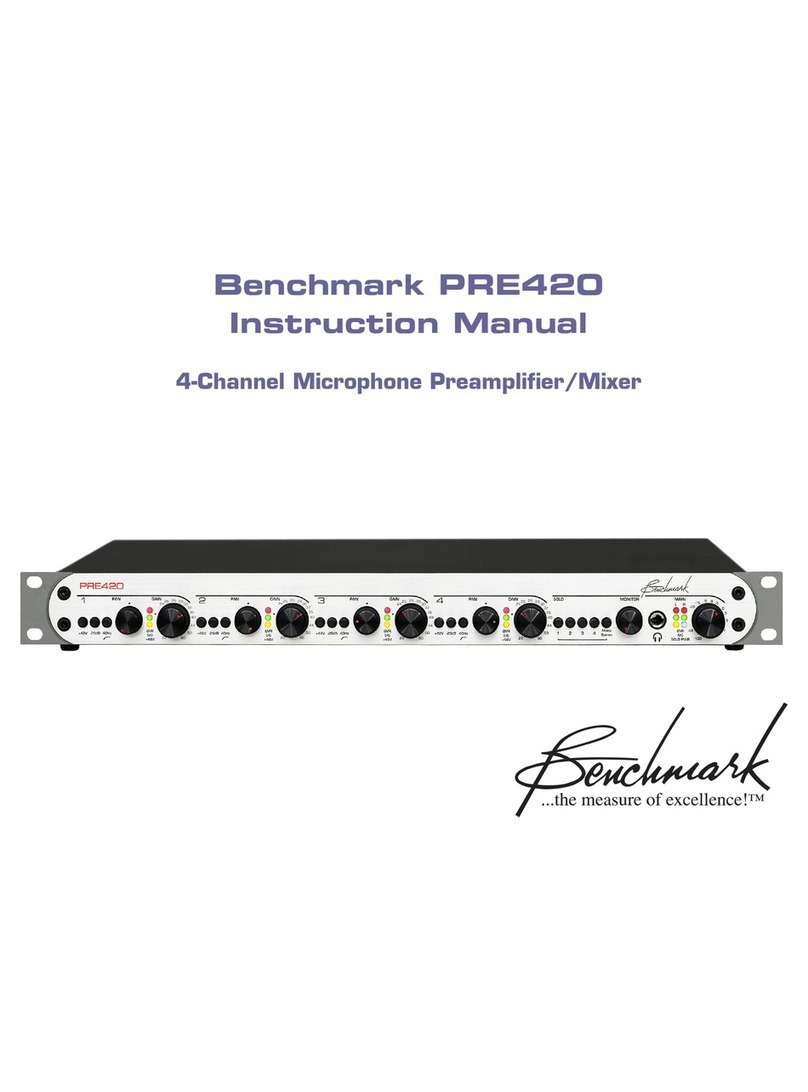
Benchmark
Benchmark PRE420 User manual
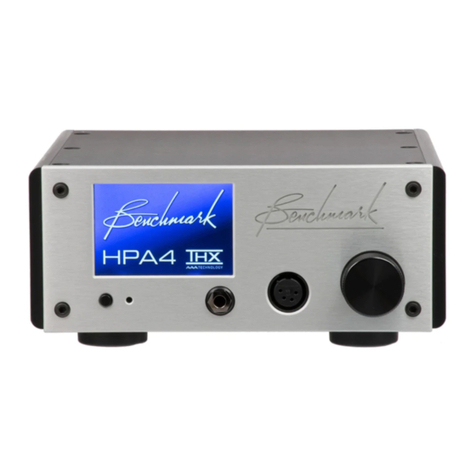
Benchmark
Benchmark HPA4 Quick start guide
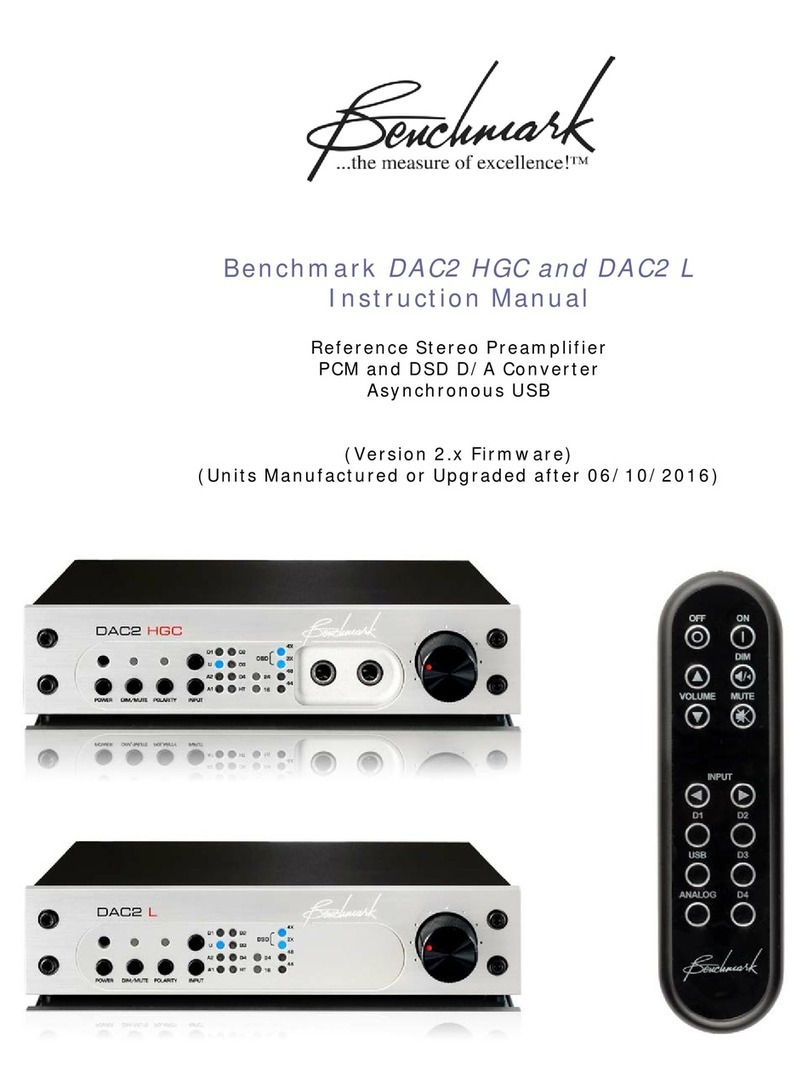
Benchmark
Benchmark DAC2 HGC User manual

Benchmark
Benchmark DAC2 HGC User manual
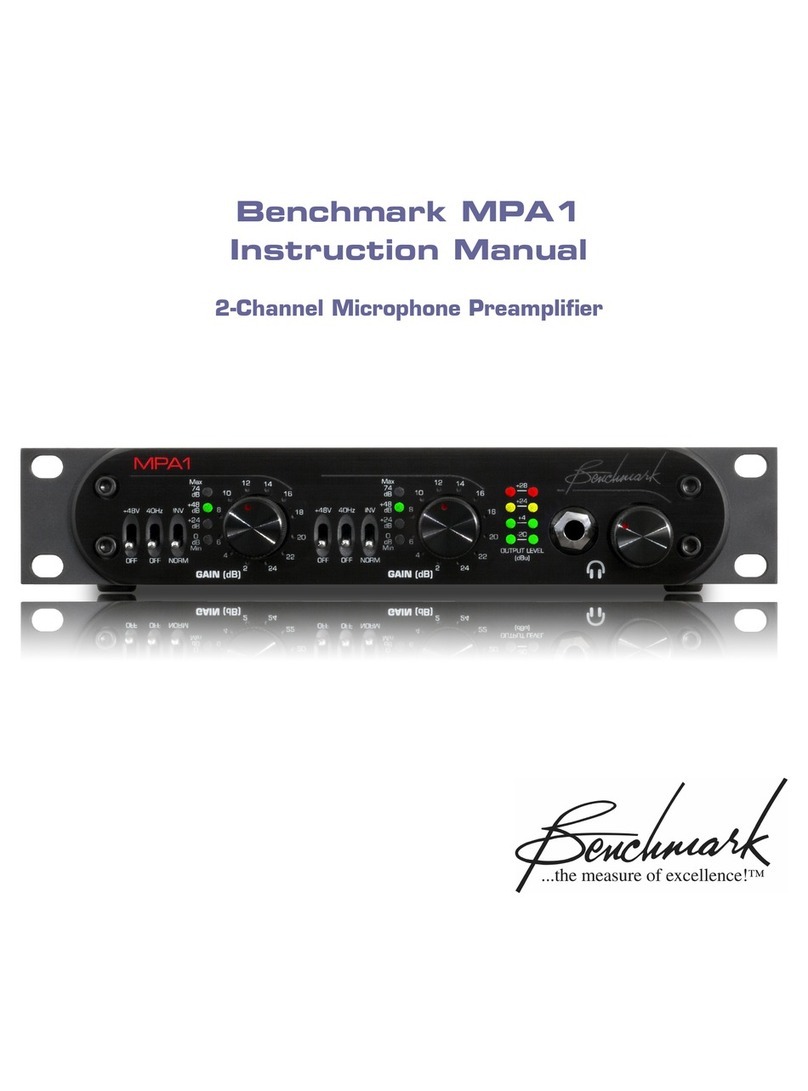
Benchmark
Benchmark MPA1 User manual

Benchmark
Benchmark DAC2 HGC User manual
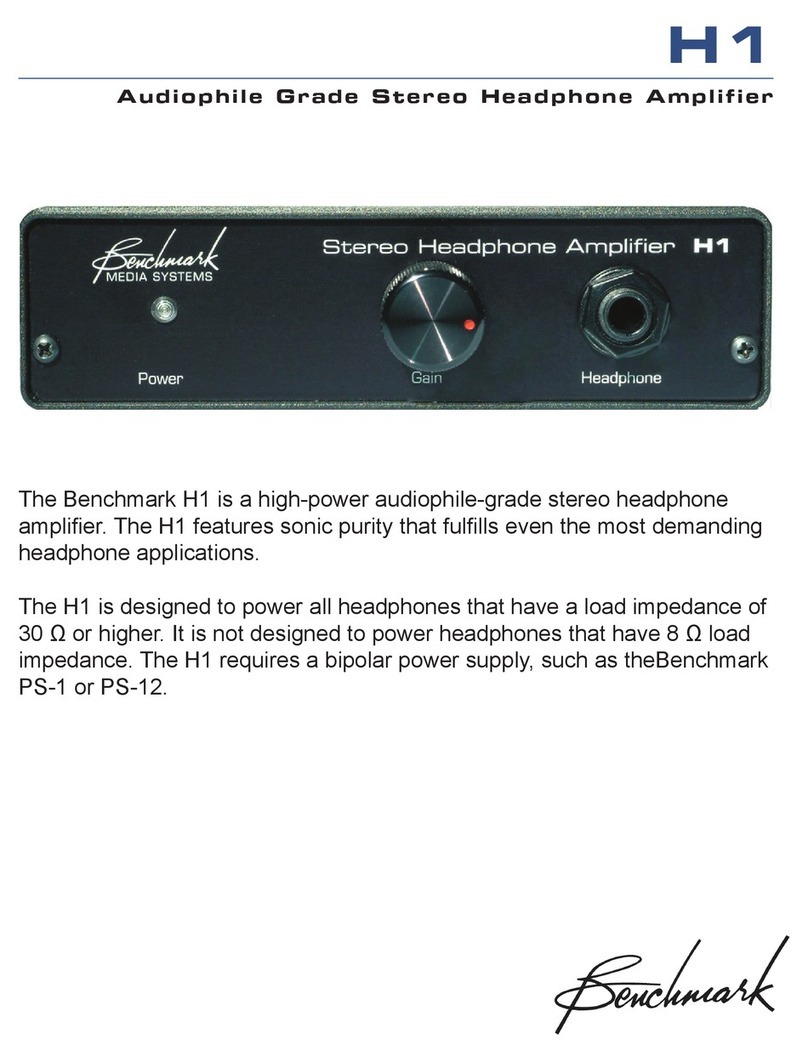
Benchmark
Benchmark h1 User manual
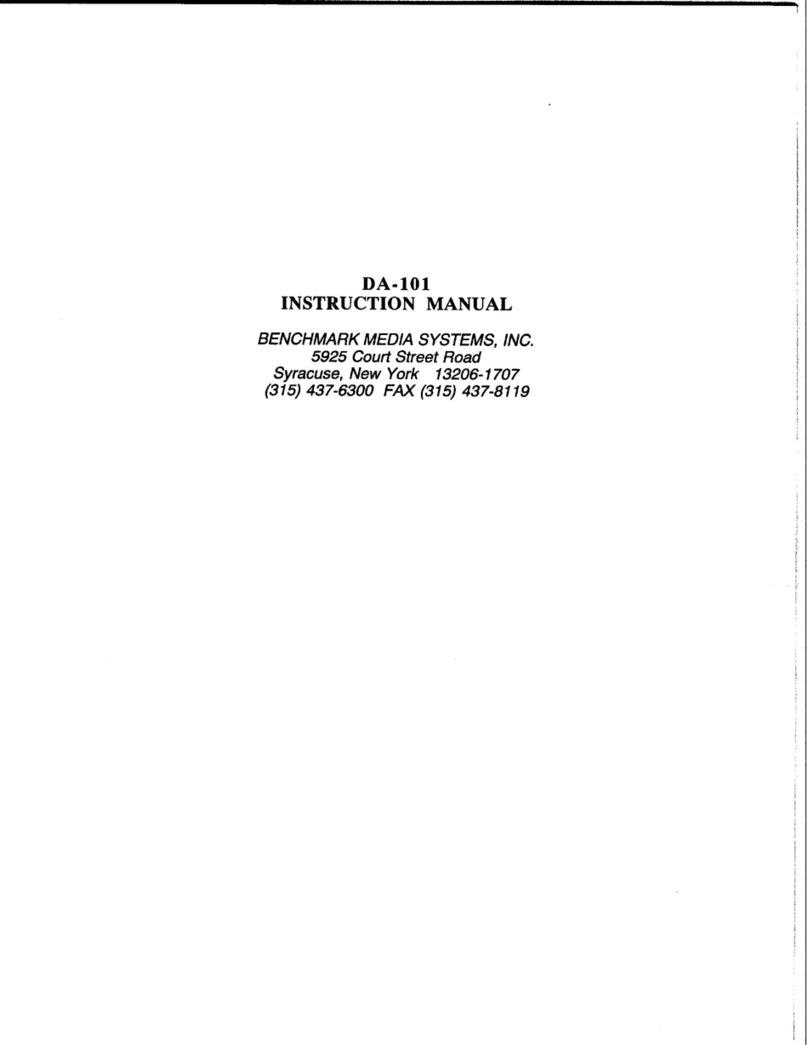
Benchmark
Benchmark DA-101 User manual

Benchmark
Benchmark HPA4 User manual

Benchmark
Benchmark DAC2 HGC User manual
